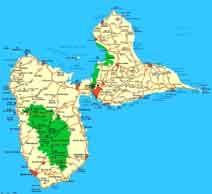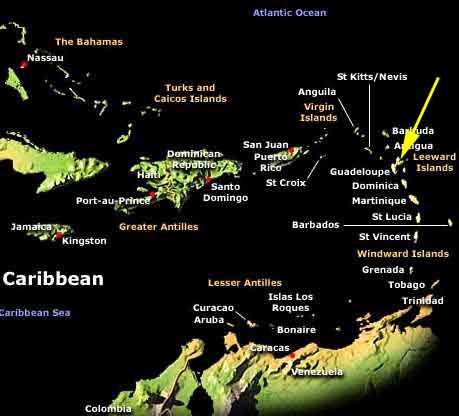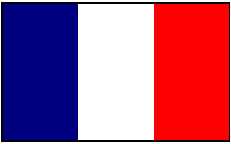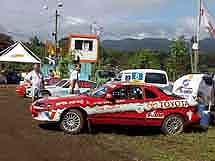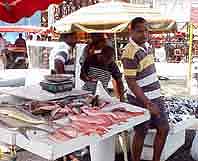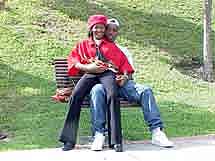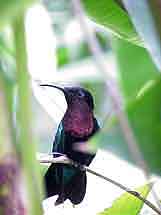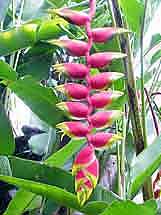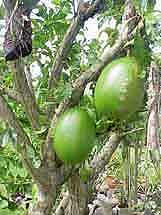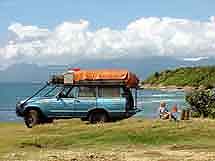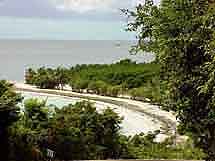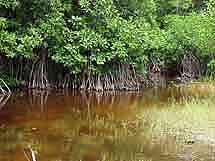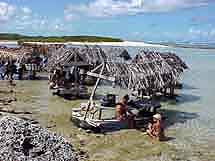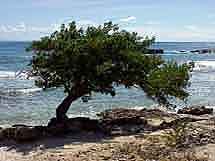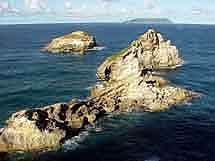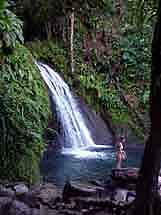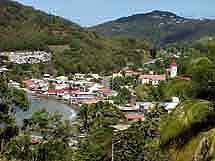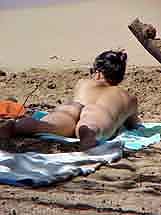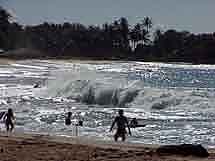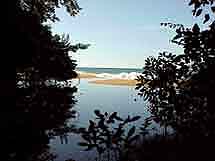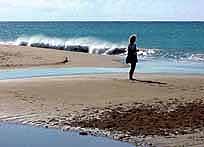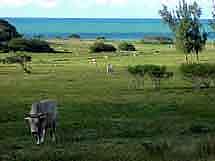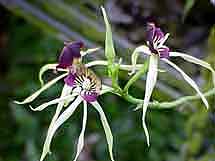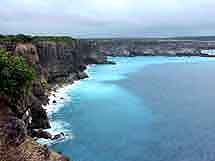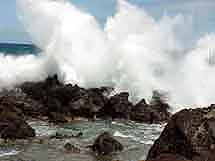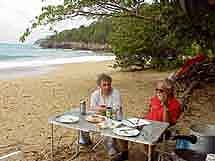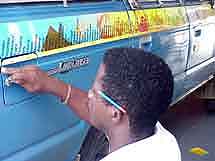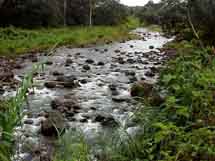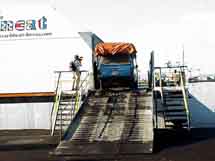![]()
Enjoy some pictures of the worldrecordtour, taken in Guadeloupe
Guadeloupe Map
|
Map of the Caribbean |
click a picture to see details |
|
|
|
|
|
|
|
Lovers in the city park of Gosier |
|
| Guadeloupe - A
flavor of France in the heart of the Caribbean
|
|||
|
Heliconia - our favorite flower |
|
|
| Repeatedly, we have been told that Guadeloupe is not Martinique. That the people are tougher and less friendly, the country more criminal - that we should be on the alert! Reciprocal, Guadeloupe speaks of their sister island as arrogant and newcomers from the Métropole. What we experience is that the standard of living is lower in Guadeloupe, but life seems more authentic due to the majority of the population being of African origin. This reflects in more modest people, more colorful markets, less clean beaches, less fences - but unfortunately also with the negative sides like graffiti everywhere - on houses, murals, traffic signs, and public telephones - and lack of maintenance and cleanliness in general.
|
|||
| Picnic on Plage St. Félix | Beach of La Saline | Mangrove swamps at La Saline | |
| Guadeloupe, the 1438 m2 big island with approx. 70'000 inhabitants was called "Karukera", i.e. "Island of beautiful waters" by their first inhabitants, the Arawak Indians. Indeed there is the sight of blue and turquoise water everywhere. The mainland consists actually of two islands - Grande-Terre and Basse-Terre. Despite being separated only by a small channel, the Rivière Salée, they are totally different. We are camping at the Western, more mountainous island of Basse-Terre, at Prise d'Eau, which is approx. 15 km from Pointe-à-Pitre, at the edge of the beautiful Goyave-River at the Guadeloupe 4x4-Club. It is a little oasis, surrounded by huge bamboo, where cattle roam, fireflies lit the night and frogs and crickets entertain us with their special concert every evening. We have the commodity of a cold shower, a toilet and a shed with a roof - actually everything we need for a comfortable camping life. Very often we are more than happy for the "roof over our heads" because we experience more rain here in the dry season than totally on all the other islands in the rainy season, not only short, heavy tropical showers, but also rain that can last for hours. Some nights, the noise of the Goyave-River increases alarmingly and makes us jump out of the car to check the water level and decide if it is already time to leave. Slowly, this wet weather starts to get on our nerves. But it is not only us who complain. Also the sugar cane farmers are not happy as the lack of sun affects the quality of their harvest. By the way: Sugar cane was introduced from New Guinea. The ripening period lasts normally 15 months.
|
|||
|
|
Impressive Rocks and the island of Désirade in Pointe des Châteaux | |
| While most of the tourist hotels are spread out on the flatter island of Grand-Terre due to the drier climate and the golden sandy beaches, Basse-Terre with its 1467 high active volcano La Soufrière is more beautiful and more untouched, but also wetter, especially on its Eastern side. It is the place where the Guadeloupe National Park with its abundance of giant leaves, lianas, hanging gardens and gigantic Philodendron, which cover the trunks of the majestic trees up to the canopy, is situated. It is said that over 300 different tropical trees and more than 90 species of orchids grow here. The beauty of this luxury rainforest with hidden waterfalls and tropical rivers fascinates us again and again. A totally new landscape opens to us on the other, Western side of the high mountain range: Huge organ pipe cacti rise towards blue skies, yellowish grass meadows replace the carpets of lush green - two worlds on one small island! But the biggest attractions on this West Coast are the many secluded sandy beaches, which stretch to the North. We explore each of them and choose "Plage de la Perle" to be the most beautiful and our favorite one.
|
|||
|
|
|
|
| Grande-Terre has a different
landscape again. Especially attractive is the rugged most Easterly "Pointe des
Châteaux", where an unpredictable rough sea is changing the scenery endlessly. High
waves are constantly splashing in high fountains against the rocks and cliffs. A quiet
contrast to this enormous force of nature are white sand banks, beautiful salt lagoons and
the island of Désirade at the horizon, which forms part of the Guadeloupe-Islands and
looks like an overturned canoe. As a result of the strong winds, only bush is growing
here, the reason why this part of the island is also called "Breton under the
Tropics". And through this vegetation of bush there are many tracks, which lead to
picturesque picnic spots under shady trees directly on the seashore. The temptation to put
up a solitary camp for a couple of days is often big. But at the end we follow the
reiterated advices of locals: Never camp alone on a beach! Therefore, despite the very
high gasoline price of € 1.05 (>$ 1.30) per liter (for us the highest ever paid
price in the world) we always return to our safe nature oasis at the Goyave-River. And
each time, we enjoy our free camping life again. How beautiful it is in comparison to the
life between all the hotels or even in comparison to the modern Marina, where the sailing
yachts dock side by side, only one meter apart from each other! |
|||
|
|
|
|
Three faces of our favorite beach "Anse de la Perle" |
|||
| Initially, we planned a maximum stay of four weeks on this French island. But at the end, it becomes six, because the urgently needed spare axle shaft has to be ordered in France and is delivered by sea freight in order to save money. Luckily, we can make a deal with the generous Toyota distributor Carmo: "Publicity against axle" so that we do not have to pay the nearly € 1000 out of our pocket. But there is also another reason for the two weeks of postponement: The Swiss TV: They decided to join us for a couple of days to film our lifestyle and adventure for their series "Fernweh - La Strada" which was broadcasted during the summer months.
|
|||
| Rural Guadeloupe at Pointe Nogent | One of the beautiful orchids of the tropics |
|
|
| On Monday morning, March 22, the "movie adventure" begins. We are very excited about it and wonder how the guy will look, as the rented car arrives exactly at 9am at our campsite in Prise d'Eau. Will we like him? As Thomas Gerber approaches us we immediately know that we will have a relaxed time together. The following filming days are a lot of fun for us and we hope that the Swiss people liked the result and we could make them dream a bit of the beautiful world. |
|||
|
|
|
|
| Finally, it is here in Guadeloupe where our LandCruiser gets its long deserved fame. Edouard Pardo of Publi-Déco and at the same time Vice President of the Guadeloupe 4x4-Club offers us to print all our already visited countries on our car. First, we are not so keen about it and do not know: Shall we or shall we not, as we know that this will attract even more people than it already does. But finally we agree to do it. And seeing the result, we are thrilled and at the same time also a bit proud of our achievement! Thomas Gerber does not lose time and takes the chance to make a little quiz with Emil questioning him about the sequence of the 145 visited countries. Well, it is not at all a problem for him, as he has the whole world map in his head!
|
|||
|
|
|
|
|
|||
|
|||
